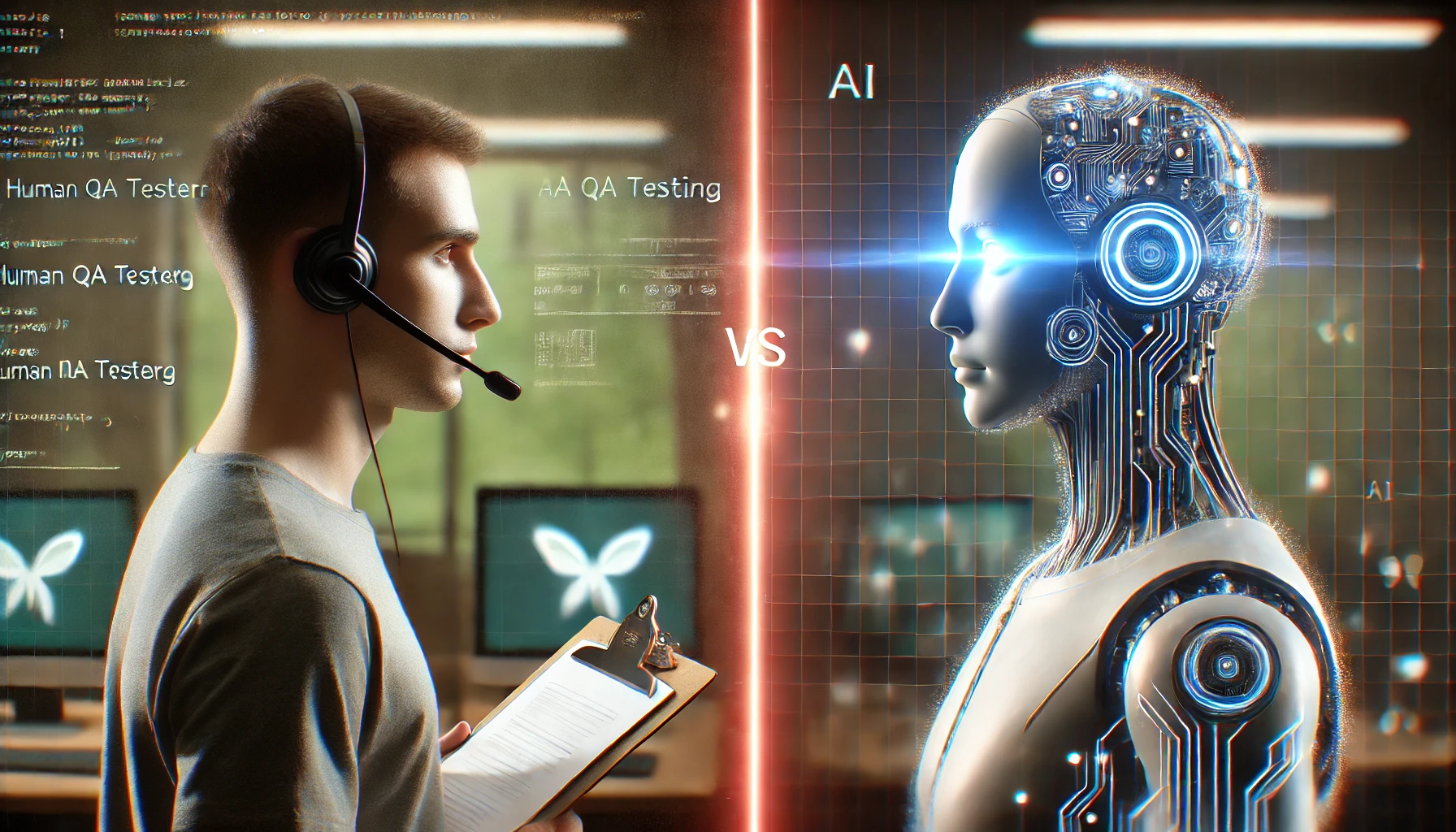AI QA agents are the smart, adaptive technology, comes to enhance, and in some instances, transform the QA process. Driven by advancements in machine learning, natural language processing, and computer vision, AI QA agents are becoming increasingly valuable in the pursuit of quality.
These agents do more than just automate things; they also add intelligence to testing, finding defects, and predicting risks. The agents can manage massive volumes of data, continue to adapt to address new challenges, and learn from past trends. The outcome is accelerated feedback, enhanced precision, and an active quality approach.
What is an AI QA Agent?
An AI QA Agent is an intelligent software program that utilizes artificial intelligence to automate and simplify quality assurance work in software development. Traditional test automation makes use of scripted statements and constant manual maintenance. AI QA agents utilize technologies like machine learning, natural language processing, and computer vision to discover application behavior, create and run test cases, learn user interface changes, and identify defects.
These agents can scan code, user stories, or previous test runs to anticipate risk areas and target testing as a result. They also interact with apps more like humans, understanding visual context and hints, thus being more immune to UI or logic modifications. AI QA agents finally serve as virtual co-pilots to QA teams, speeding up testing velocity, accuracy, and efficiency and allowing human testers to concentrate on quality strategies of greater scope.
The Evolution of AI in Quality Assurance (AI QA)
The evolution of AI in Quality Assurance (QA) mirrors the improved sophistication of modern software and the need for faster and more accurate testing.
QA started first with being entirely manual, test cases being handwritten and executed by hand, often leading to sluggish cycle times and human error. The following stage was characterised by the application of automated test tools such as Selenium and JUnit that enhanced regression testing but were not yet easy to script, maintain, and update upon changes to applications. With software development embracing agile and DevOps methodologies, continuous testing demands have outgrown conventional automation. This created a window of opportunity for QA solutions based on AI.
The initial AI integrations consisted of employing machine learning for the analysis of past test data and risk-based prioritization of test cases. More sophisticated features gradually came into existence, including self-healing tests that quickly change according to modifications in the UI, natural language generation of tests, and predictive analytics for the determination of high-risk code areas.
Today’s AI QA agents can generate tests independently, perform visual testing through computer vision, and even comprehend application behavior sufficiently to simulate actual user interactions. The journey continues from static testing practices to adaptive, smart, and autonomous QA systems that collaborate with humans to guarantee software quality at scale.
Read Also: How AI is Transforming Digital Content Creation: The Future of Visual Media
Key Technologies Powering AI QA Agents
AI QA agents are changing quality assurance by mimicking human judgment, speeding up testing, and finding problems more accurately. The agents may act intelligently, adaptively, and on their own thanks to a mix of cutting-edge technologies that are driving this revolution. Let’s delve into the principal technologies behind their abilities.
Machine Learning (ML)- AI QA agents’ backbone is machine learning. Through training on past data, such systems come to recognize patterns, project defects, and maximize testing procedures. In QA, ML is employed for:
- Defect prediction: Determining the sections of the application most susceptible to bugs according to previous defects and code complexity.
- Test case prioritization: Dynamically reordering test cases to execute the most important ones.
- Anomaly detection: Detection of outliers within data, logs, or behavior at runtime that may represent latent defects.
Natural Language Processing (NLP)- NLP allows for human language understanding and processing by AI QA agents, so they are incredibly useful for test automation and documentation analysis. Usage is in:
- Automatic test case generation: Converting user stories or requirements to executable test scripts.
- Test documentation analysis: Parsing and comprehension of specs, change logs, or bug reports to realign testing attention.
- Chatbots and voice agents: Assisting QA engineers by responding to questions or navigating through test output.
Computer Vision- In UI/UX testing, visual inspection is very important. Computer vision enables AI QA agents to “look” and analyze visual elements with accuracy.
- UI testing: Identifying UI mismatches, layout issues, and visual regressions.
- Product inspection: Detecting surface imperfections, misalignments, or absent parts in a real application.
- Visual diff testing: Comparing automatically images or screenshots to identify visual discrepancies.
Reinforcement Learning (RL)- Reinforcement learning allows AI agents to learn the best actions by experimentation and trial. In QA:
- Self-improving test strategies: Agents learn and evolve testing strategies as per test results and feedback.
- Smart exploratory testing: The agent automatically explores various areas of the application to reveal unintended behavior.
- Test environment tuning: RL enables tuning test environments and test sequences for improved coverage and performance.
Predictive Analytics- Predictive analytics assists AI QA agents in predicting possible quality defects and taking preventive measures ahead of time.
- Risk-based testing: Preemptive prediction of modules that might fail and allocating resources accordingly.
- Release readiness scoring: Assessing whether software is ready for release based on trends in defects and performance.
- Failure trend analysis: Detection of recurring failures and their root causes before affecting end users.
Robotic Process Automation (RPA)- RPA supports AI in automating repetitive QA processes that don’t need deep intelligence but consume much time.
- Automated regression testing.
- Data entry and validation while testing.
- When combined with AI, RPA is more adaptive and context-aware, boosting end-to-end QA automation.
- Workflow orchestration between systems.
Cloud and Edge Computing- AI QA agents take advantage of distributed computing to scale testing and monitoring across environments, platforms, and devices.
- Scalable test execution in the cloud.
- On-demand test environments using containerization and virtualization.
- Real-time quality monitoring at the edge (e.g., in IoT devices).
Benefits of Using an AI QA Agent
The introduction of an AI QA agent in the software testing process has numerous benefits that improve efficiency and effectiveness in QA processes. The following are the most significant advantages:
- Accelerated Testing Cycles: AI QA agents automate repetitive work and execute tests much faster than manual testers or traditional automation tools. They allow teams to meet rigid release schedules and encourage continuous testing in agile and DevOps environments.
- Less Maintenance Effort: In contrast to manual automation, which is flimsy when the UI or logic is altered, AI QA agents deliver self-healing features. It updates tests automatically when elements change or identifiers are modified.
- Improved Defect Detection: AI can identify subtle bugs by identifying patterns and anomalies in app behavior. It assists in identifying problems that may escape traditional scripts or manual checks.
- Cost Efficiency in the Long Run: While setup could be costly initially, AI QA agents greatly lower test creation, test execution, and test maintenance time and expense in the long run.
- Scalability: AI QA agents can scale as easily as the development pipeline, running big, complicated test suites on many platforms, devices, or environments without a growth in QA team size.
- Natural Language Test Creation- Certain AI agents enable testers to create test scenarios using plain English. This makes it possible for non-technical stakeholders to contribute and lowers the new team member’s learning curve.
Best practices for implementing AI QA Agent
Mentioned below are some best practices for implementing the AI QA Agent:
- Define Clear Objectives: Before deploying an AI QA agent, one needs to define clear goals, e.g., increasing test coverage, speeding up test runs, or decreasing production defects. Having clearly defined objectives assists in model choice, data setup, and performance measurement, so the AI complements the overall QA plan.
- Start Small and Scale Up: Implement AI QA in steps by starting small, manageable pilot projects. Applying it to certain test cases or modules allows us to measure effectiveness, learn from issues, and refine the implementation before scaling it to the entire QA process.
- Provide High-Quality Training Data: AI QA agent performance is heavily dependent on data quality and diversity on which they are trained. Uncluttered, labelled, and proportional data sets, such as defect logs, historical test results, and code changes, encourage the AI to make precise predictions and practical recommendations.
- Integrate with CI/CD Pipeline: Testers can obtain full efficiency by incorporating AI QA agents into their continuous integration and delivery pipeline. This enables AI-based tests and insights to run automatically for every code change, resulting in more reliable releases, quicker feedback, and early defect discovery.
Within CI pipelines, test teams can leverage AI-based testing at scale on real browsers and devices through cloud platforms designed for seamless integration. Combining AI capabilities with advanced analytics and smart test orchestration enables early problem detection, allowing teams to release software with greater confidence.
LambdaTest offers AI testing tools for developers and testers, including LambdaTest KaneAI, a GenAI-native testing agent that helps teams plan, author, and evolve tests using natural language. KaneAI is built specifically for high-speed quality engineering teams and integrates effortlessly with LambdaTest’s broader test planning, execution, orchestration, and analysis features.
By utilizing AI prompts for testing through KaneAI, teams can generate intelligent test cases, automate maintenance, detect flaky tests, and enable smart reruns to maintain test reliability across builds.
LambdaTest’s cloud infrastructure supports real-time parallel testing on over 3,000 environments, including real browsers, devices, and operating systems.
With robust reporting, root cause analysis, and smooth integration with popular CI tools like Jenkins, GitHub Actions, and GitLab, teams can reduce manual effort, accelerate testing cycles, and consistently deliver high-quality applications.
- Emphasize Explainability and Transparency: There should be a requirement that AI choices in QA are explainable and traceable. Employ models and tools with explainability of predictions or failures so that testers and developers can identify issues effectively and maintain trust in the application.
- Regular Re-Evaluation and Monitoring: AI models can become obsolete as applications develop. Uniform monitoring and retraining on contemporary data permits precision and applicability to stay in place while the AI adapts to varying codebases, testing necessities, and organisation needs.
Conclusion
In conclusion, the use of AI QA agents is growing rapidly, since quality is increasingly standing out in terms of competitiveness and end-user satisfaction. By adding flexibility, scalability, speed, and predictive analytics to the mix, intelligent machines are revolutionising quality assurance. With each deployment, organisations that take this step now will be better equipped to handle the challenges of tomorrow.
However, implementing AI QA agents requires more than technology. It requires clearly stated goals, clean data, human guidance, and cross-functional collaboration. When applied judiciously, AI allows QA teams to work better, identify problems earlier, and deliver more significant outcomes.
You May Also Like: Why Cloud Testing Beats Local Testing (Unless You Love Headaches)










